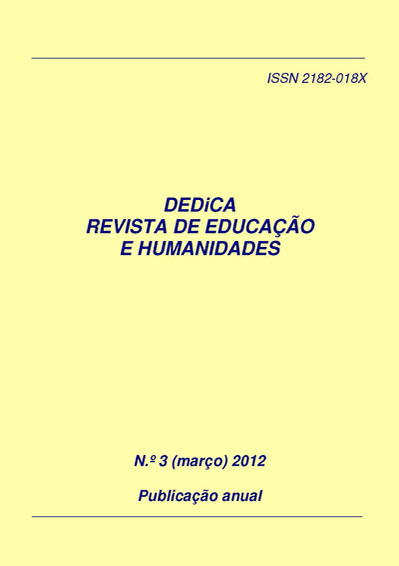Música e tradições da Trácia (Grécia): um instrumento pedagógico transcultural
DOI:
https://doi.org/10.30827/dreh.v0i3.7094Palavras-chave:
Trácia, música, danças, influência multi-cultural, identidade nacional, ensino transculturalResumo
A localização geopolítica, bem como o itinerário histórico da Grécia através do tempo, transformou o país num lugar de encontro das culturas europeias, norte-africanas e do Médio Oriente. Fábulas, crenças e cerimónias religiosas, elementos linguísticos, danças tradicionais e a música das diferentes regiões do espaço helénico são testemunho desta convergência cultural. Uma destas regiões é a Trácia. O objectivo deste artigo é, em primeiro lugar, tratar da música e das danças da Trácia e destacar através delas as influências tanto dos Balcãs como do Médio Oriente. Em segundo lugar, através de uma exposição de aulas de música realizadas nos últimos anos, em escolas e universidades da Trácia moderna, iremos averiguar se a música é ou não um instrumento útil de comunicação – uma língua internacional – para alunos da Trácia. Por último, estudaremos a influência destas diferentes “tradições” sobre o comportamento de alunos.Downloads
Referências
Abril, C. (2006). Learning of two approaches to multicultural music education. International Journal of Music Education, 24, 1 (2006) 30-42.
Abril, C. (2002). Chiildren’s Attitudes towards Languages and Perception of Performers’ Social Status in the Context of Songs. International Journal of Music Education, 39, 1 (2002) 65-74.
Αυδίκος, Ε.; Παπαδάκης, Γ.; Γκουβέντα, Ε. (Επιμ.) (2002). Μουσική και Μουσικοί της Θράκης (Music and Musicians of Thrace). Αλεξανδρούπολη: Ε.Π.Α.Δ.Α.
Benham, S. (2003). Being the Other Adapting to Life in a Culturally Diverse Classroom. Journal of Music Teacher Education, 13, 1 (2003) 21-32.
Burton, B. J. (2010). Multicultural Resources. General Music Today, 24, 1 (2010) 58-62.
Clements, A. (2009). Minority Students and Faculty in Higher Music Education. Music Educators Journal, 95, 3 (2009) 53-56.
Diamantis, T. (1996). Thrace in Antiquity. In N. Desyllas, Thrace, colours and hues, 22-25. Athens: Synolo.
Διονυσόπουλος, Ν. (1994). Η μουσική της Θράκης: μουσικές περιοχές, ρυθμοί, χοροί και όργανα. Στο Τραγούδια και σκοποί της Θράκης. Χρόνης Αηδονίδης (The music of Thrace: musical regions, rhythms, dances and instruments, in Songs and melodies of Thrace. Hronis Aidonidis). Ηράκλειο: Πανεπιστημιακές Εκδόσεις Κρήτης.
Doukas, D. (1996). The prefecture of Evros. In N. Desyllas, Thrace, colours and hues, 33-34. Athens: Synolo.
Elliott, D. (1989). Key Concepts in Multicultural Music Education. International Journal of Music Education, 13, 1 (1989) 11-18.
Legette, R. M. (2000). Social Context and Music Learning, General Music Today, 13, 3 (2000) 16-18.
Letts, R. (1997). Music: universal language between all nations? International Journal of Music Education, 29, 1 (1997) 22-31.
Liapis, A. K. (1996). The prefecture of Rodopi. In N. Desyllas, Thrace, colours and hues, 32-33. Athens: Synolo.
Λυκεσάς, Γ. (1993). Οι Ελληνικοί Χοροί (Greek Dances). Θεσσαλονίκη: University Studio Press
Μαυροειδής, Μ. (1999). Οι μουσικοί τρόποι στην Ανατολική Μεσόγειο (Musical modes in Eastern Mediterranean). Αθήνα: Fagotto.
Μαυροειδής, Μ. (1994). Ανθολογία Ελληνικής παραδοσιακής μουσικής (Anthology of Greek Traditional Music). Αθήνα: Fagotto.
Μαυροειδής, Μ. (1992). Οι τρόποι της παραδοσιακής μουσικής (The modes of traditional music). Αθήνα: ΙΕΜΑ.
McCarthy, M. (1997). A Sociocultural approach to creativity. General Music Theory, 10, 3 (1997) 10-15.
McCrary, J. (2000). Ethnic Majority/Minority Status: Children’s Interactions and Affective Responses to Music. Journal of Research in Music Education, 48, 3 (2000) 249-261.
Magno Prim, F. (1995). Tradition and change in children’s games: its implication in music education. Bulletin of the Council for Research in Music Education, 127 (1995) 149-154.
Miralis, Y. (2006). Claryfying the Terms “Multicultured”, “Multiethnic” and “World Music Education” through a Review of Literature. Application of Research in Music Education, 24 (2006) 54-66.
Mousopoulos, T. (1996). The turning point of the late Byzantine period and the years of Ottoman rule. In N. Desyllas, Thrace, colours and hues, 28-30. Athens: Synolo.
Mousopoulos, T. (1996). A New Era: Antitheses and Syntheses. In N. Desyllas, Thrace, colours and hues, 30-31. Athens: Synolo.
Mousopoulos, T. (1996). The prefecture of Xanthi. In N. Desyllas, Thrace, colours and hues, 31-32. Athens: Synolo.
Παπαναστασίου, Β. (χ.χ.). Μουσικές καταγραφές της Θράκης (Music transcriptions in Thrace). Αθήνα: Νάκας.
Palmer, A. (1994). On Cross-Cultural Music Education. Journal of Music Teacher Education, 4, 1 (1994) 19-24.
Poirazidis, K.; Samara, S. (1996). Thrace: a stroll through nature’s realm. In N. Desyllas, Thrace, colours and hues, 35-37. Athens: Synolo.
Πυργιώτης, Δ. Θησαυρός μουσικών κλιμάκων (Collection of musical scales). Αθήνα: Fagotto.
Σακελλαρίδης, Γ. (2010). Οδηγός διαπολιτισμικής εκπαίδευσης (Guide of transcultural education). Αθήνα: Πεδίο.
Συργιώτη, Ε. (χ.χ.). Τα τραγούδια του κόσμου (Songs of the world). Αθήνα: Fagotto.
Triantaphyllos, D. (1996). Thrace in Antiquity. In N. Desyllas, Thrace, colours and hues, 22-25. Athens: Synolo.
Τυροβολά B. (1998). Ελληνικοί Παραδοσιακοί Χορευτικοί Ρυθμοί (Greek traditional dance-rhythms). Αθήνα: Gutenberg.
Vuillamy, G.; Shepherd, J. (1984). The application of a critical sociology to music education. British Journal of music Education, 1 (1984) 247-266.
Zikos, N. (1996). A Byzantine ramble through Thrace. In N. Desyllas, Thrace, colours and hues, 25-28. Athens: Synolo.












